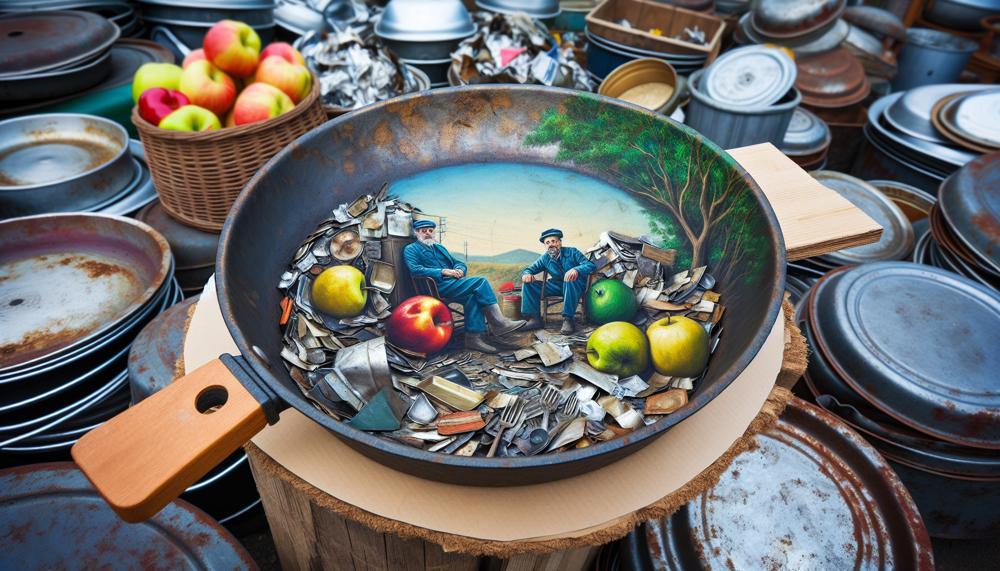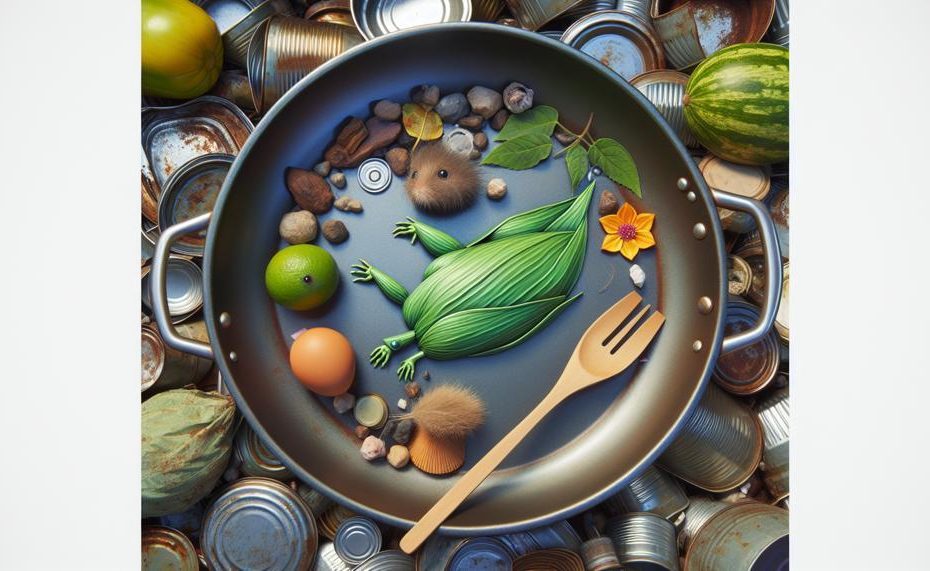Tired of constantly replacing your worn-out frying pans? Feeling guilty about contributing to the ever-growing waste in landfills? It’s time for a change. Say goodbye to the cycle of buying and discarding cookware, and hello to a more sustainable lifestyle.
Recycling frying pans not only benefits the environment but also saves you money in the long run.
In this blog post, we’ll delve into the world of recycling frying pans and explore creative ways to repurpose them at home. Get ready to reduce your carbon footprint and give your old cookware a new purpose. Here are some key points we’ll cover:
- The environmental impact of discarded frying pans
- The advantages of recycling and repurposing old frying pans
- Innovative ideas for repurposing old frying pans
- A step-by-step guide on how to recycle frying pans at home
- Tips for maintaining and extending the lifespan of your new or recycled frying pan
Join us on this journey towards sustainable living by giving your old frying pans a new life.
Let’s dive into the world of recycling and discover how small changes can make a big difference.
Contents
Can Frying Pan Be Recycled?
Yes, frying pans can be recycled, but it depends on the materials they are made of. The recycling process may vary depending on the specific material, so it is crucial to check with locally available recycling programs for guidelines.
- Check for recyclable materials: Before attempting to recycle a frying pan, it is essential to confirm if it is made of materials that can be recycled. While most recycling programs accept metal frying pans such as stainless steel and aluminum, pans made of other materials like copper or cast iron may not be recyclable and should be disposed of in the garbage.
- Clean the pan: Properly cleaning the frying pan before recycling is crucial. This means removing any food residue or grease from the surface, which makes the recycling process more efficient and reduces contamination.
- Find a scrap metal recycling facility: If your frying pan is made of metal, you can recycle it through a scrap metal recycling facility. These facilities melt down the metal and reuse it in new products. It is vital to check with local councils or recycling centers for options and guidelines.
- Repurpose or donate: Instead of recycling, you can also repurpose your old frying pan or donate it to charity. Frying pans can serve as planters, storage containers, or kitchen tools. They can also be donated to thrift stores or non-profit organizations.
- Special considerations for non-stick frying pans: Non-stick frying pans coated with Teflon can also be recycled, but the coating must be removed first by heating the pan at high temperatures. If this is not possible, these pans can still be reused for various purposes or donated to organizations.
Are Frying Pans Recyclable?

Frying pans are essential kitchen tools that we use almost daily. However, like any other item in our household, they eventually become worn out and need to be replaced.
But what should you do with your old frying pans? Can you recycle them? The answer is yes, but there are several steps you need to follow to ensure proper recycling and contribute to a more sustainable environment.
Step 1: Check the Material
The first step in recycling your old frying pans is to determine if they are made of recyclable materials. Most frying pans made of aluminum, stainless steel, or cast iron can be recycled.
However, if your pan is made of other materials like ceramic or glass, it is best to check with the manufacturer for proper disposal instructions.
Step 2: Clean the Pan
Before recycling, make sure to clean your pan thoroughly. Remove any food residue or grease and give it a good scrub with soap and water.
This ensures that the pan is safe for recycling and prevents any contamination during the recycling process.
Step 3: Remove Non-Recyclable Parts
Some frying pans may have non-recyclable parts such as plastic handles or coatings. These should be removed before recycling.
You can either try to remove them yourself or take the pan to a scrap yard where they have specialized equipment for separating different materials.
Step 4: Recycle at a Scrap Yard
The best way to recycle your old frying pan is by taking it to a scrap yard.
These facilities specialize in recycling scrap metals and will properly process your pan. This ensures that the materials are recycled in an environmentally friendly manner.
Step 5: Check Local Recycling Programs
Many local governments have recycling programs that accept scrap metal.
Check your local government website for information on how to properly dispose of your frying pan. This is another convenient option for recycling your old frying pans.
Step 6: Repurpose or Donate
If your frying pan is still in good condition, consider repurposing it for another use or donating it to a thrift store or secondhand store. This not only prevents waste but also gives your old frying pan a new life.
Step 7: Special Considerations for Non-Stick Pans
Non-stick pans require special considerations when recycling.
The non-stick coating can release harmful chemicals if incinerated, so make sure to take these pans to a specialized recycling facility or contact the manufacturer for proper disposal instructions.
How Can I Recycle My Frying Pan?
Once all possibilities for reusing or repurposing your old frying pan have been exhausted, the most environmentally friendly option is to recycle it.
However, as mentioned in the previous section, not all local recycling centers accept frying pans due to the difficulty in separating different materials and non-stick coatings.
So, what are some alternative eco-friendly options for recycling your old frying pan?
There are several eco-friendly options for recycling your old frying pan, including:
- Check with your local recycling center: The first step is to check with your local recycling center to see if they accept frying pans. If they do, follow their specific instructions for proper recycling.
- Sell it to a scrap metal collector: If your local recycling center does not accept frying pans, you can sell them to scrap metal collectors. They will typically melt down the metal and repurpose it into new products.
- Donate it to charity homes: Another option is to donate your old frying pan to charity homes or thrift stores. While they may not be able to resell it, they can send it to a scrap yard for recycling.
- Give it to children for play: Children love playing with toy kitchens and utensils, so giving them your old frying pan can be a fun and eco-friendly way to repurpose it.
- Repurpose the pan for camping: If you enjoy camping or outdoor activities, you can repurpose your old frying pan for cooking over a campfire or using it as a makeshift plate or bowl.
- Check for special instructions for non-stick pans: Non-stick pans require special handling and disposal due to their coating. Check with the manufacturer or your local recycling center for specific instructions on how to properly recycle them.
In summary, when searching for eco-friendly options for recycling your old frying pan, remember to check with your local recycling center, consider selling it to scrap metal collectors or donating it, repurpose it for children’s play or camping, and check for special instructions for non-stick pans.
By recycling your old frying pan, you not only reduce waste and pollution, but also contribute to the creation of new products from recycled materials.
What Happens To Frying Pans When They Are Recycled?
The recycling process for frying pans is a multi-step procedure that involves carefully separating the various materials and preparing them for reuse.
Before a pan can even be considered for recycling, it must first be checked for its materials and cleanliness. This is crucial as different types of materials require different recycling methods. For instance, non-stick frying pans need to have their coating removed before they can be melted down and reused. This ensures that the recycled material is of high quality and free from impurities.
Once the frying pan has been accepted for recycling, it goes through a series of steps to prepare it for reuse. This includes sorting the materials, shredding them into smaller pieces, melting them down in a furnace, and removing any impurities.
This process not only helps to conserve resources but also reduces waste by giving new life to old frying pans.
Furthermore, this process also helps to reduce the amount of energy and resources needed to produce new frying pans from raw materials.
Can I Recycle My Non-stick Frying Pan?
Recycling a non-stick frying pan may seem like a daunting task, but with the right knowledge and resources, it can be done easily and effectively. Here are some key steps to take when recycling a non-stick frying pan:
- Identify the Material and Coating: The first step is to determine the material and coating of your non-stick frying pan. This information is essential in determining the appropriate recycling method.
- Check with Local Recycling Programs: Contact your local government or waste management service to see if they accept frying pans for recycling. Some programs may require you to remove the non-stick coating or handle before recycling.
- Look for Mail-in Programs: Certain manufacturers offer mail-in programs for recycling their products. Keep in mind that you may need to cover the shipping cost or meet specific criteria to qualify.
- Donate Non-metal Cookware: If your frying pan is made of ceramic, glass, or other non-metal materials, consider donating it to a thrift store or charity if it is still in good condition.
Where Can I Recycle My Non-stick Frying Pan?
- Recycling Centers: Many areas have dedicated recycling centers that accept non-stick frying pans. These facilities are typically run by private companies that specialize in processing and recycling various materials.
- Municipal Recycling Programs: Some cities have municipal recycling programs that accept non-stick frying pans. Check your local government website or recycling hotline for more information.
- Manufacturer Mail-in Programs: As mentioned earlier, some manufacturers offer mail-in programs for their products. Visit the manufacturer’s website or contact their customer service to see if they have such a program.
- Thrift Stores or Charities: If your frying pan is still in good condition, consider donating it to a thrift store or charity instead of throwing it away.
| Recycling Center | Municipal Recycling Program | Manufacturer Mail-in Program | Thrift Stores or Charities |
| Yes | Yes | Yes | If in good condition |
By following these proper steps and utilizing the available recycling options, you can ensure that your non-stick frying pan is properly disposed of and potentially given a second life. Recycling not only helps reduce waste but also promotes sustainability and conserves resources for future generations.
Are There Any Restrictions On Recycling Frying Pans?
Recycling frying pans can be a complex process with various restrictions and guidelines to adhere to. Here are some common considerations to keep in mind:
Material Limitations
Frying pans are usually composed of a mixture of materials such as aluminum, stainless steel, or cast iron. However, not all materials are accepted in curbside recycling programs as they can be difficult to separate and recycle.
This is particularly true for non-stick pans, which have a layer of coating that needs to be removed before recycling.
Local Recycling Guidelines
While some scrap metal recycling facilities may accept frying pans, it’s important to check with your local council or recycling center first.
They may have specific guidelines or restrictions for accepting frying pans, so it’s best to confirm before dropping them off.
Alternative Disposal Options
If your local program does not accept frying pans, there are other ways to dispose of them responsibly.
Consider repurposing your old frying pan as a planter, storage container, or even as a kitchen tool if it’s still in good condition. You can also donate it to charity or give it to someone in need.
Sanitization
Before recycling your frying pan, make sure to thoroughly clean it to avoid contamination. This includes removing any remaining food or residue and ensuring that the pan is free of any non-recyclable materials.
Non-Stick Pan Considerations
Non-stick frying pans require special consideration when it comes to recycling.
The non-stick coating contains chemicals that can be harmful to the environment if not disposed of properly. To recycle a non-stick pan, the coating must be removed first by heating it at high temperatures.
Reuse or Donate
Rather than discarding your non-stick frying pan, consider reusing it or donating it to reduce waste and harm to the environment.
You can repurpose it for other cooking tasks or give it to someone who may need it.
Conclusion
In conclusion, recycling frying pans is a powerful way to reduce waste and protect our planet.
Not only does it contribute to a more sustainable lifestyle, but it also gives old cookware a chance for a new purpose. By following simple steps like checking for recyclable materials and properly cleaning the pan, we can all play a role in creating an eco-friendly world.
Don’t let worn-out frying pans end up in landfills when they can be transformed into something new through recycling or alternative options. Let’s bid farewell to constantly replacing our cookware and instead embrace a more sustainable approach.





